
FeaturesSpring Flowers
along the Odakyu Lines
There are many places along the Odakyu Lines to enjoy the abundant seasonal flora. Here we take a look at some of the well-known places that are popular among sightseers, and provide some information about great cherry blossom viewing locations that are favorites among locals. Experience unique local settings and Japanese spring in new ways!
Flower Viewing Calendar

Cherry Blossoms
Every year when spring arrives, Japan is abuzz with talk of the blooming of cherry blossoms. The soft pink color of the blossoms puts a sense of springtime into people's hearts, producing a dazzling spectacle together with the spring sunshine. Visit Japan during this season and experience the beauty of cherry trees in springtime.
Greater Shinjuku Area
-
Shinjuku Gyoen

Shinjuku Gyoen is a botanical oasis in the middle of the city. Its vast grounds of 583,000 square meters are characterized by English landscape, French formal and Japanese gardens, filled with seasonal plants and scenery.
Some 1,300 cherry trees of around 65 different varieties are planted in the gardens, and the blossoms come into bloom in turn from end of February through end of April. The especially popular Yoshino cherry trees are best seen from the end of March to the beginning of April. In addition, various types of yaezakura such as ichiyo, kanzan and fugenzo are particulary worth seeing.
Cherry blossoms against a backdrop of city buildings makes for a distinctly Tokyo-style sightseeing experience.
Please note that playing sports or musical instruments is not allowed on the garden grounds. Also, alcoholic beverages purchased off-premise may not be consumed in the gardens.- Best Time to See
- End of February to end of April (depending on the cheery blossom variety)
- Types of Cherry Blossom Trees
- Approximately 65 types including Oshima, Yoshino, ichiyo, kanzan and fugenzo
- Getting to the Place
- 10-minute walk from Shinjuku Station South Entrance
-
Shinjuku Central Park
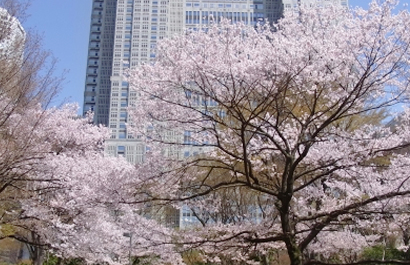
Shinjuku Central Park is located next to the skyscraper district of Nishi-Shinjuku. Relax in the lush green environment of the park while gazing up at the Tokyo Metropolitan Government buildings and other towering structures.
When in bloom, the cherry trees are delightful. Enjoy the blossoms of such trees as the Yoshino variety, including the Takato kohigan variety with its characteristic deep pink-colored blossoms. Blooming cherry blossom trees juxtaposed between tall buildings unite the cityscape and nature.- Best Time to See
- From end of March to beginning of April
- Types of Cherry Blossom Trees
- Higan, Yoshino, others
- Getting to the Place
- 10-minute walk from Shinjuku Station West Entrance
-
Kitazawa Riverwalk
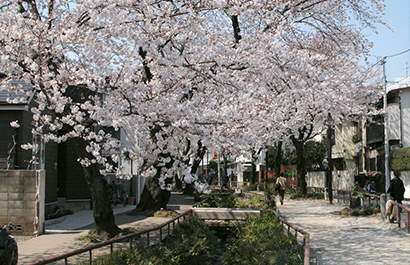
There is a variety of greenery to be enjoyed along the Kitazawa Riverwalk, and visitors throng here during the cherry blossom viewing season. The entire riverwalk spans 4.3 kilometers. What a great way to embrace spring in Japan with all your senses!
- Getting to the Place
- Nearest stations: Shimo-Kitazawa, Setagaya-Daita
-
Senkawa River
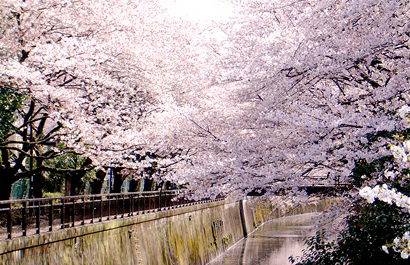
The cherry blossom trees lined along both banks with the reflection of the blossoms glimmering in the Senkawa River is the epitome of spring. In early April, the trees are bathed in a magical lighting by Toei, a prominent Japanese film and television production company.
- Getting to the Place
- Nearest station: Seijogakuen-mae
-
Soshigaya Park
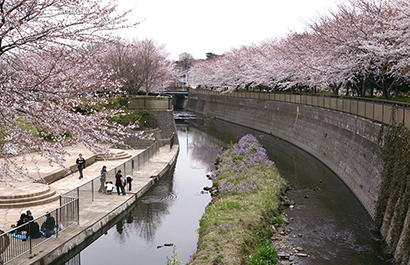
Centered on the site where the former Tokyo University of Education had a farm, this park unfolds over 10 hectares. The cherry blossoms running along the right bank of the Senkawa River were donated as "homecoming cherry blossom trees." They were originally seedlings grown from cherry blossom trees in Potomac Park gifted by the mayor of Tokyo in 1912.
- Getting to the Place
- 10-minute walk from Shinjuku Station West Entrance
Hakone/Odawara Area
-
Miyagino
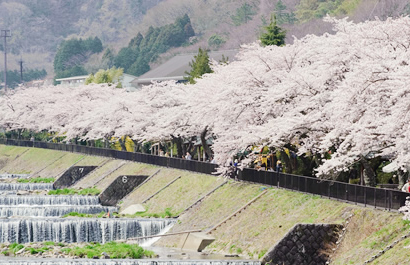
Miyagino is located in the mountains of Hakone. Lines of cherry trees extend for around 600 meters along the banks of the local Hayakawa River. Cherry blossom viewing is exceptionally beautiful here during the flowering season, thanks to the ambience created by the sound of flowing river and other natural features. Enjoy the wonders of springtime at this popular Hakone cherry tree site, either by taking in the full blossoms a short distance away from the riverbank or by walking through cherry blossom tunnels formed by the arching branches at the top of the bank.
Close to the Miyagino bus stop and the banks of Hayakawa River, you will also find a little-known gem of a spot with rows of weeping cherry blossom trees. This is a highly recommended area to visit.
Limited to the peak of the cherry blossom period, illumination is provided after dark, providing a cherry blossom viewing experience that is completely different from daytime viewing.- Best Time to See
- End of February to end of April (depending on the cheery blossom variety)
- Types of Cherry Blossom Trees
- Approximately 65 types including Oshima, Yoshino, ichiyo, kanzan and fugenzo
- Getting to the Place
- 10-minute walk from Shinjuku Station South Entrance
-
Hakone Gora Park
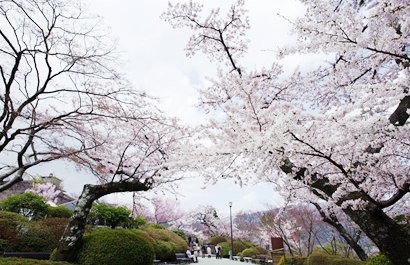
Hakone Gora Park is a French-style garden located on Sounzan, which can be reached by the Hakone Tozan Cable Car. Enjoy the seasonal flowers, as well as cafés, shops and Japanese tearooms, and encounter Hakone’s natural environment together with Japanese culture. The garden has several types of cherry blossom trees to enjoy, including the Yoshino variety, the Fuji cherry with its adorable flowers, and the wild cherry unique to mountainous regions. Come to Hakone Gora Park for a relaxing outing, viewing the cherry blossoms while strolling around the spacious grounds.
Admission costs 550 yen but is free of charge if you have a Hakone Freepass.- Best Time to See
- From beginning to mid-April
- Types of Cherry Blossom Trees
- Yoshino, jugatsu,weeping, Fuji, wild
- Getting to the Place
- Take the Odakyu Limited Express Romancecar from Shinjuku Station to Hakone-Yumoto Station, 85 minutes. Then take the Hakone-Tozan train to Gora Station, and transfer to the Hakone Tozan Cable Car. Get off at either Koen-Shimo Station or Koen-Kami Station, and walk for approximately 1 minute.
-
Houraien Park
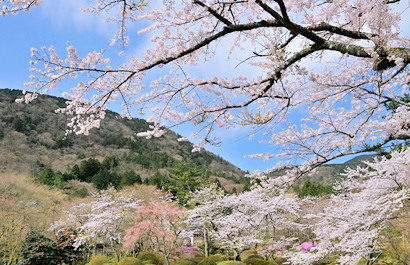
This grand garden features the Mikawaya Ryokan, a Japanese style inn located in Kowakidani, Hakone National Park. Houraien is a Japanese-style garden with exquisitely maintained trees on a vast site 66,000 square meters in size. During the cherry blossom season, Yoshino and weeping cherry blossom trees bring vivid beauty to the park. There is also open space where you can spread a blanket to sit and enjoy the scenery.
Why not also visit Hakone Kowakien Yunessun, a nearby hot springs amusement park and spa resort?
In addition to its cherry blossom trees, Houraien Park is also famous for its 30,000 azaleas that bloom in May and the gorgeous tree colors in autumn.- Best Time to See
- From beginning to mid-April
- Types of Cherry Blossom Trees
- Yoshino, weeping, other
- Getting to the Place
- Take the Odakyu Limited Express Romancecar from Shinjuku Station to Hakone-Yumoto Station, 85 minutes. Then take the Hakone-machi (H) route of the Hakone-Tozan Bus to the Houraien bus stop, 19 minutes. The garden is immediately adjacent.
-
Odawara Joshi Park
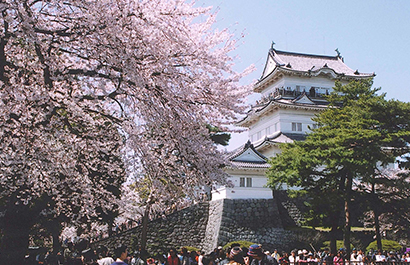
This park was selected as one of the 100 best places for cherry blossoms in Japan by the Nihon Sakura no Kai for the 320 cherry blossom trees accompanied by the Odawara Castle Donjon and moat. A cherry blossom festival is held during the blossom period, and the paper-covered lamps give the park a mystical sense at night.
- Getting to the Place
- Nearest station: Seijogakuen-mae
-
Saikachi-koji Street
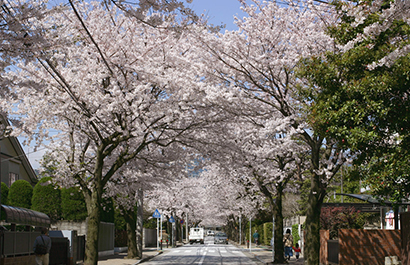
Saikachi-koji is a street that is home to a number of samurai mansions, the large plots of land and homes giving a tranquil appearance but with a hidden past. Some 50 Yoshino cherry blossom trees create a beautiful tunnel of blossoms in spring.
- Getting to the Place
- Nearest station: Odawara
Kamakura Area
-
Dankazura and Tsurugaoka Hachiman-gu Shrine
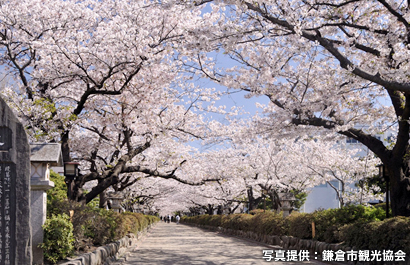
Tsurugaoka Hachiman-gu shrine is a historical shrine located in Kamakura. An old road approximately 500 meters long (the "Dankazura") leads to the shrine, and there are some 300 cherry trees along the sides of the road. When the cherry blossom season arrives, this forms a pink tunnel, dazzling shrine visitors. Cherry blossom trees bloom on the shrine grounds at the end of the road, where you can also enjoy the view of cherry blossoms reflected on the surface of Genji Pond. There are restaurants and shops to visit on the nearby Komachi-dori Street. Stop by and explore while you're in the area!
- Best Time to See
- From end of March to beginning of April
- Types of Cherry Blossom Trees
- Yoshino, other
- Getting to the Place
- Take the Odakyu Limited Express Romancecar from Shinjuku Station to Fujisawa Station, 60 minutes. Then take the Enoshima Electric Railway to Kamakura Station at the end of the line, 34 minutes, and walk approximately 5 minutes.
-
Rows of Cherry Blossom Trees in Kamakurayama
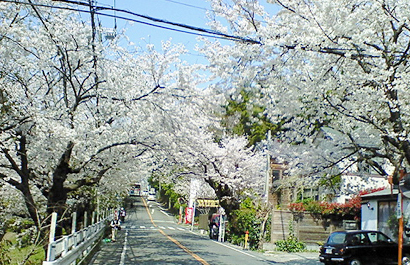
A small hill a short distance from the center of Kamakura, Kamakurayama features a 3-kilometer road lined with rows of cherry trees that people flock to see when the blossoms start to bloom. Immerse your senses in the Japanese springtime by taking a walk through the cherry blossom tunnel formed by the trees arching across the road. When you come to view the cherry blossom trees, remember to check out the stylish cafés and restaurants in the area!
- Best Time to See
- From end of March to beginning of April
- Types of Cherry Blossom Trees
- Yoshino
- Getting to the Place
- Take the Odakyu Limited Express Romancecar from Shinjuku Station to Fujisawa Station, 60 minutes. Then take the Enoshima Electric Railway to Kamakura Station at the end of the line, 34 minutes. Board the Keihin Kyuko Bus bound for Kamakurayama/Enoshima via Kamakurayama and get off at the Tokiwaguchi bus stop, 12 minutes.
-
Hase-dera Temple
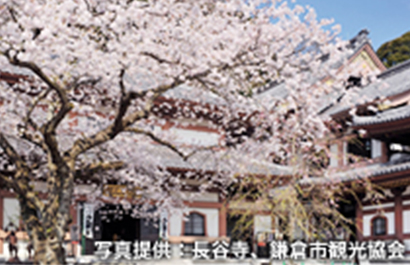
The grounds of historical Hase-dera temple have a garden with a walking path along which you can enjoy viewing various flowers in each season. In the cherry blossom season, the ancient Japanese tradition of flower viewing is brought home when you see the cherry blossoms against this backdrop of old buildings within the temple grounds.
- Best Time to See
- From end of March to beginning of April
- Types of Cherry Blossom Trees
- Yoshino, weeping
- Getting to the Place
- Take the Odakyu Limited Express Romancecar from Shinjuku Station to Fujisawa Station, 60 minutes. Then take the Enoshima Electric Railway to Hase Station, 29 minutes, and walk for 5 minutes.
-
Kamakura Great Buddha - Kotaku-in temple
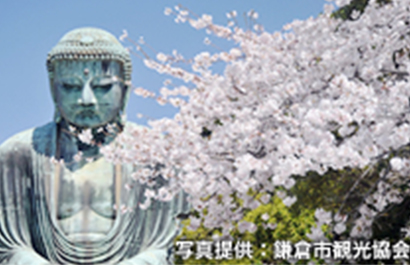
Kotoku-in temple with the Kamakura Great Buddha is a popular sightseeing spot. A special treat that can be enjoyed only during the cherry blossom season is the view of pink flowers within the temple grounds set in excellent color contrast to the blue-tinged Great Buddha statue.
- Best Time to See
- From end of March to beginning of April
- Types of Cherry Blossom Trees
- Yoshino
- Getting to the Place
- Take the Odakyu Limited Express Romancecar from Shinjuku Station to Fujisawa Station, 60 minutes. Then take the Enoshima Electric Railway to Hase Station, 29 minutes, and walk for 10 minutes.
Shiba-sakura
The season of fresh green leaves also marks the blooming of shiba-sakura, the moss phlox variety of cherry blossoms. The scenery of large grounds covered in a soft carpet of aromatic shiba-sakura is a popular draw for tourists.
Fuji Area
-
Fuji Shibazakura
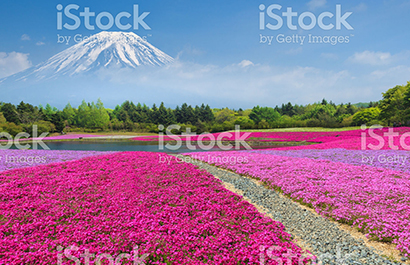
From mid-April to the end of May every year is the flowering time for the moss phlox variety of cherry blossoms, and during that time, the Shiba-sakura Festival is held near Lake Motosu, one of the Fuji Five Lakes. The vast grounds boast some 800,000 cherry blossom trees.
The carpet of white and pink moss phlox cherry blossoms as contrasted wtih the majesty of Mount Fuji is a sight to be behold.- Best Time to See
- From mid-April to end of May
- Getting to the Place
Azaleas
Take a trip to these locations and enjoy the beautiful scenery filled with azeleas.
Hakone Area
-
Odakyu Hotel de Yama
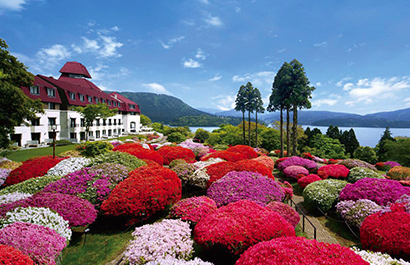
Standing on the shores of Lake Ashi, Odakyu Hotel de Yama greets a season of azeleas in May. The extensive gardens are right next to Lake Ashi and facing a beautiful fiew of Mount Fuji. Enjoy the resplendent beauty of 3,000 azeleas representing some 30 different varieties planted along the hills. The main garden path is paved for easy walking, and ramps provide easy access for wheelchairs and those who have difficulty walking. Enjoy this tour of flowers!
- Best Time to See
- From beginning to mid-May
- Getting to the Place
- Take the Hakone Tozan Bus (H Line) from Hakone-Yumoto Station, 38 minutes. Get off at the Moto-Hakone-ko bus stop and walk for 15 minutes.
Alternatively take the Odakyu Hakone Highway Bus from Shinjuku Station to the Odakyu Hotel de Yama bus stop, 146 minutes. The hotel is immediately adjacent.
-
Hakone Gora Park
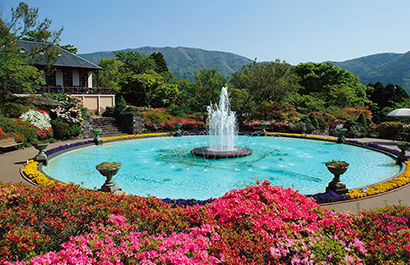
This park features 1,000 azeleas of 8 different varieties. Enjoy the rich variety of colors provided by the azealeas around the fountain along with the beautiful rhododendrons that bloom at the same time. Other botanical delights are the bougainvillea and tropical plants in the greenhouse.
- Best Time to See
- From beginning to mid-May
- Getting to the Place
- Take the Odakyu Limited Express Romancecar from Shinjuku Station to Hakone-Yumoto Station, 85 minutes. Then take the Hakone Tozan Train to Gora Station and transfer to the Hakone Tozan Cable Car. Get off at either Koen-Shimo or Koen-Kami Station and walk for approximately 1 min.
-
Hakone Hotel Kagetsuen
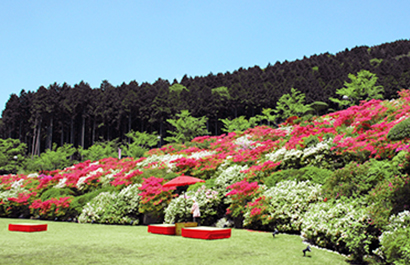
The gardens at Hakone Hotel Kagetsuen in Sengokuhara stand with the gardens at Odakyu Hotel de Yama as famous spots for azeleas in Hakone. The contrast between the fiery red and snow-white azeleas here is particularly beautiful.
- Best Time to See
- From beginning to end of May
- Getting to the Place
- Take the Hakone Tozan Bus (T Line) from Hakone-Yumoto Station and get off at the Minami-Onsen-so bus stop, 32 minutes. The hotel is immediately adjacent. Alternatively take the Odakyu Hakone Highway Bus from Shinjuku Station to the Minami-Onsen-so bus stop, 130 minutes.
-
Houraien Park
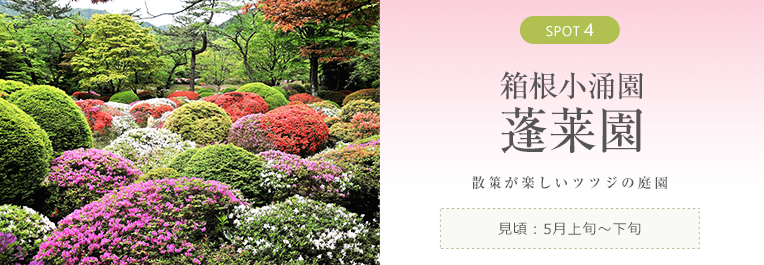
Horaien, which is a garden at Hakone Kowakien, was opened in the 1910s and is well known for its azeleas. Stroll freely around the extensive grounds of some 1.6 hectares to see more than 30,000 azeleas and satsuki (Rhododendron indicum) flowers.
- Best Time to See
- From Beginning to end of May
- Getting to the Place
- Take the Odakyu Limited Express Romancecar from Shinjuku Station to Hakone-Yumoto Station, 85 minutes. Then take the Hakone-machi Line (H Route) of the Hakone Tozan Bus to the Horaien bus stop, 19 minutes. The garden is immediately adjacent.


